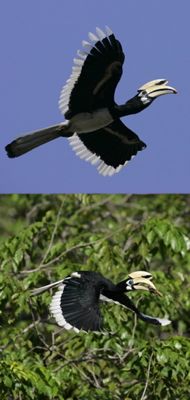While the female Oriental Pied Hornbill (Anthracoceros albirostris) was busy sealing herself inside a cavity in an old Shorea tree at Changi in February 2007, another pair was doing the same nearby. This time it was an old angsana tree (Pterocarpus indicus) by the main road. The cavity was at the point where a branch was originally lopped off from the main trunk.
The male hornbill was seen making numerous trips delivering lumps of mud to the female inside the cavity (above). In one particular day he was seen doing five sessions within a 30 minutes period. Large pieces of mud were carried in his beak and offered to the female. The female carefully bit off small pieces each time until the whole lump either disappeared or disintegrated. When the lumps were hard, the female would have trouble pecking off pieces. There were no problems when the large lumps appeared softer.
The male would not allow the female to take over the whole piece of mud, especially when it was a large lump. If it slipped from the beak of the female due to her clumsiness, the male would invariable retrieve it to offer it for her again. Sometimes the male had trouble getting the lumps through the opening, trying this way and that for up to eight minutes each time.
The delivery of mud continued from the 17th to 24th February. After eight days of mud delivery, the female had yet to completely seal herself in.
On 24th March the female was seen spending some time nest cleaning. Obviously with so much mud being delivered, there would be plenty of debris that needed to be removed. She continued to ‘shovel’ debris out of the nest at least 26 times on one occasion.
In between delivering mud, the male was delivering food (left). Fruits were delivered by regurgitating once every 4-6 seconds. Each time he would deliver 10-50 fruits, depending on size. With smaller fruits like figs, more could be stored in the male’s gullet. It took some skill to regurgitate the fruits and channel them to the end of the beak, then skillfully transfer them to the tip of the female’s beak that was stuck out of the entrance of the cavity. A number of times the transfer failed and the male had to do it again. Sometimes he had to re-swallow the fruits and regurgitate them again for proper positioning.
Most of the time the food transfer was successful, if not the first time, then a second or even a third try.
During the period when the cavity was being actively sealed (17-24 February), the food delivered was mainly fruits. After this period there were more non-fruits. It was not easy to identify the animal food that was regurgitated and passed on to the female.
Melinda and Chan Yoke Meng.
Singapore
May 2007










